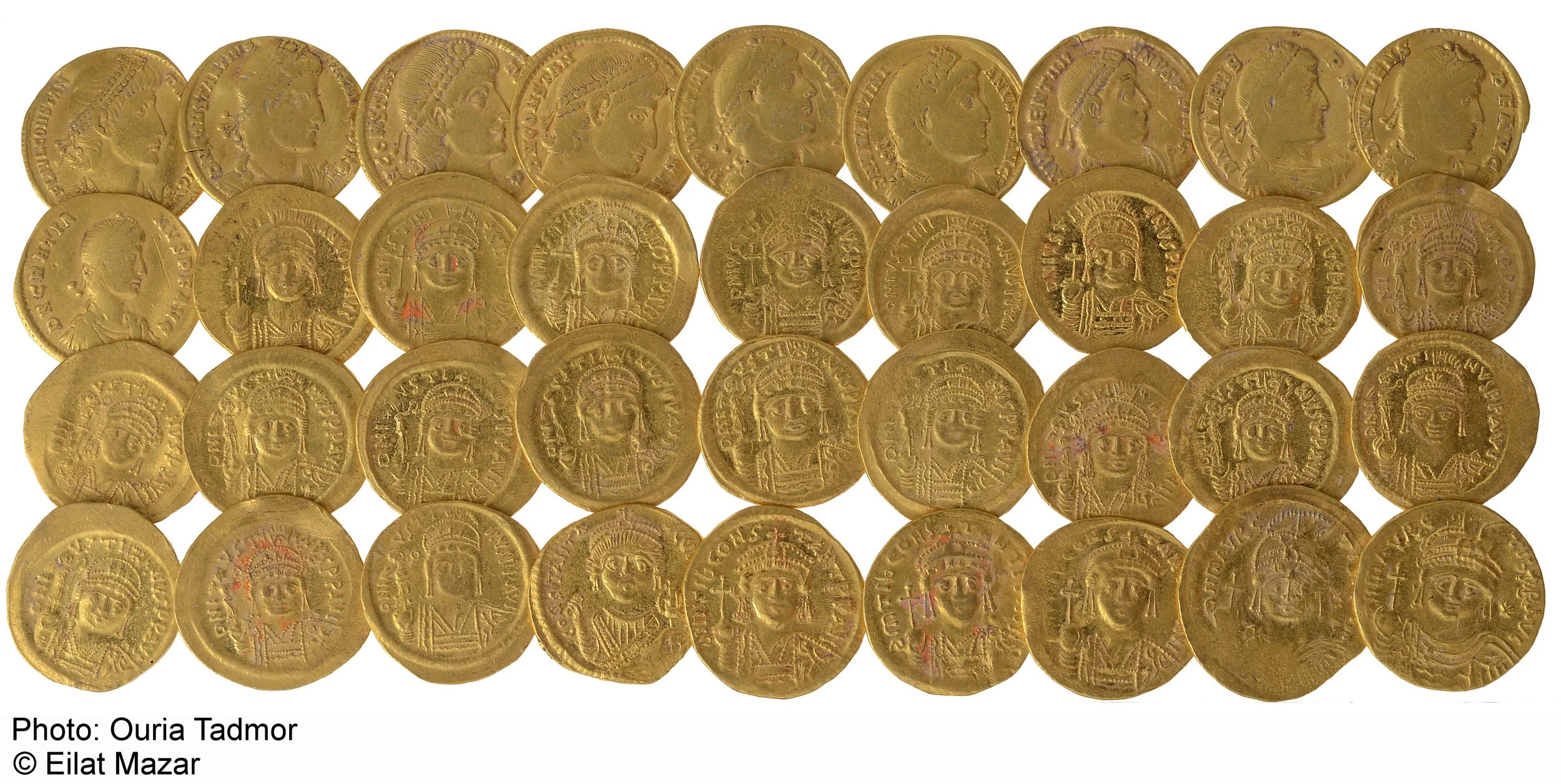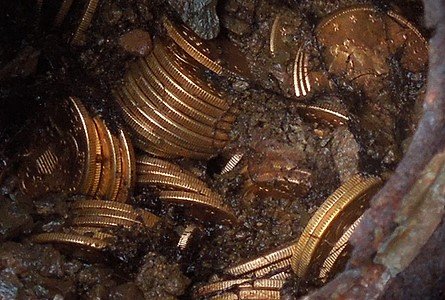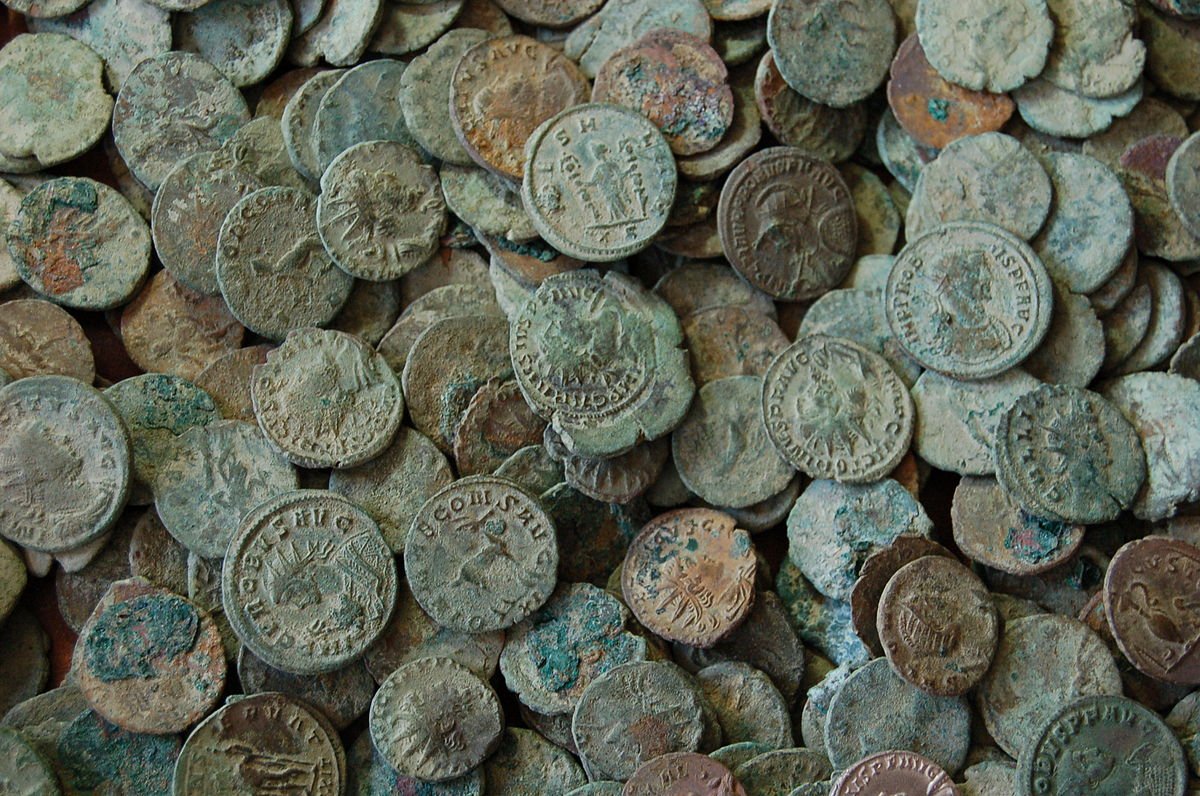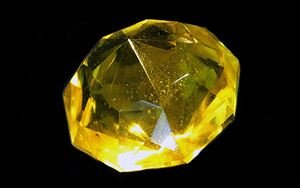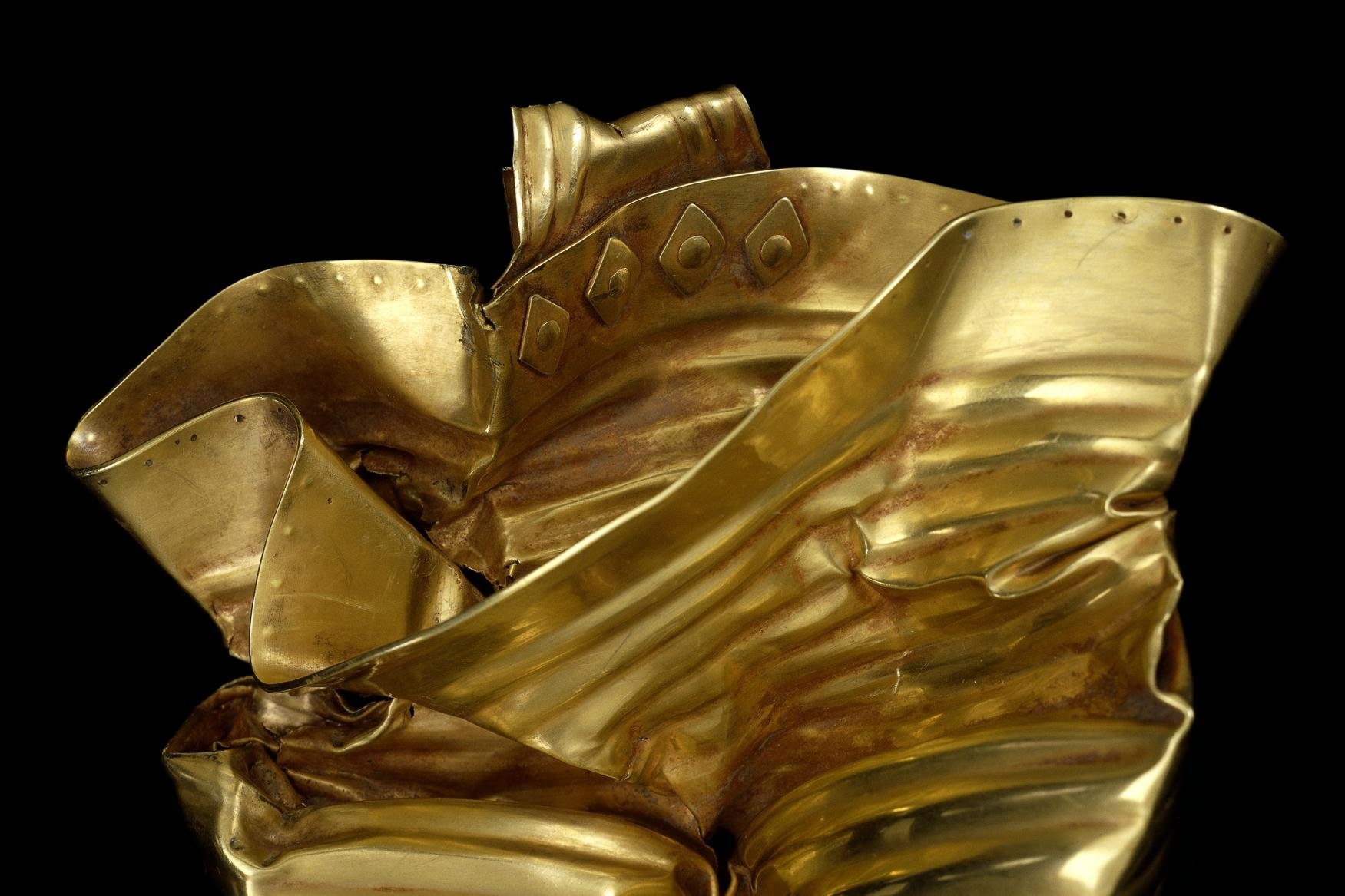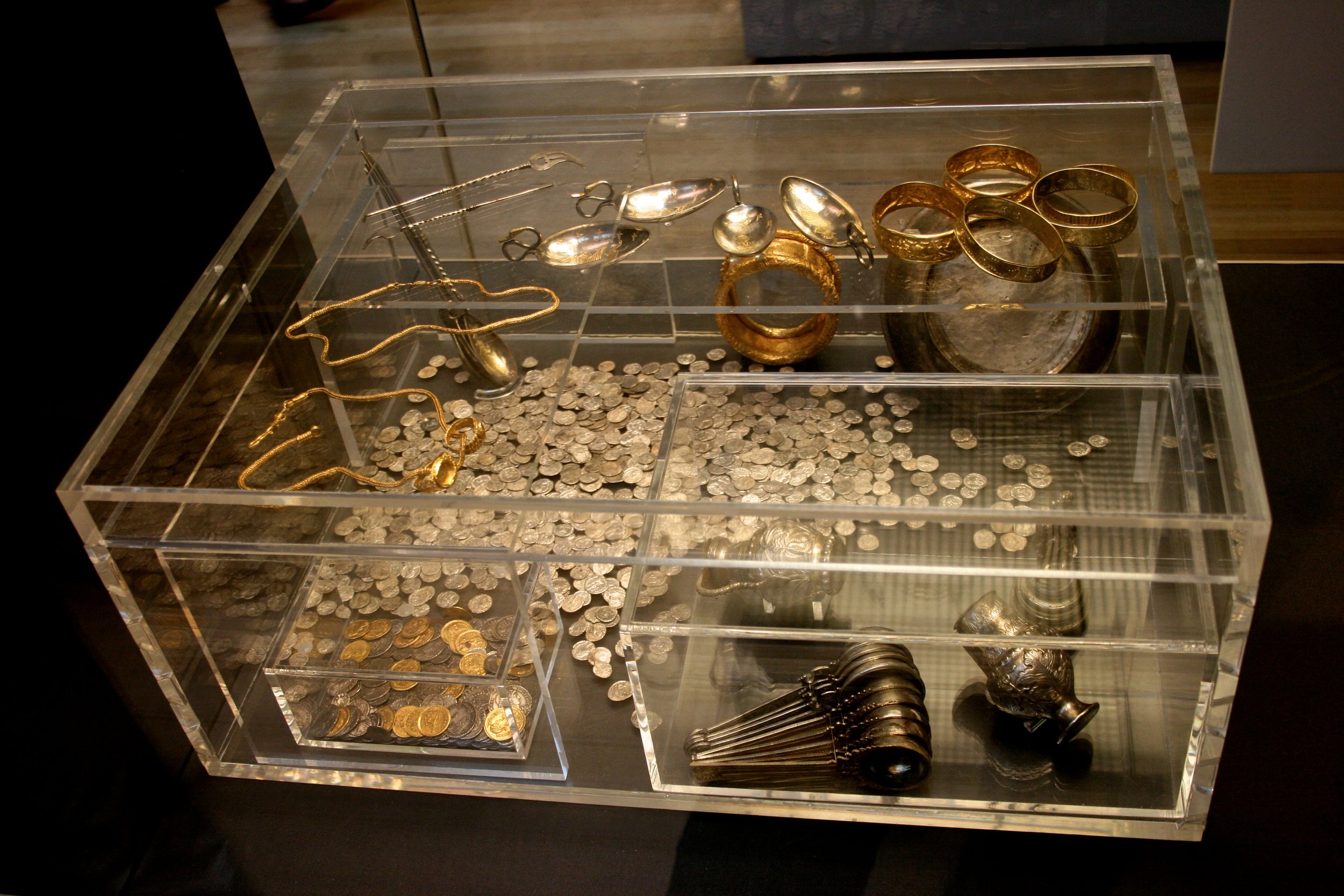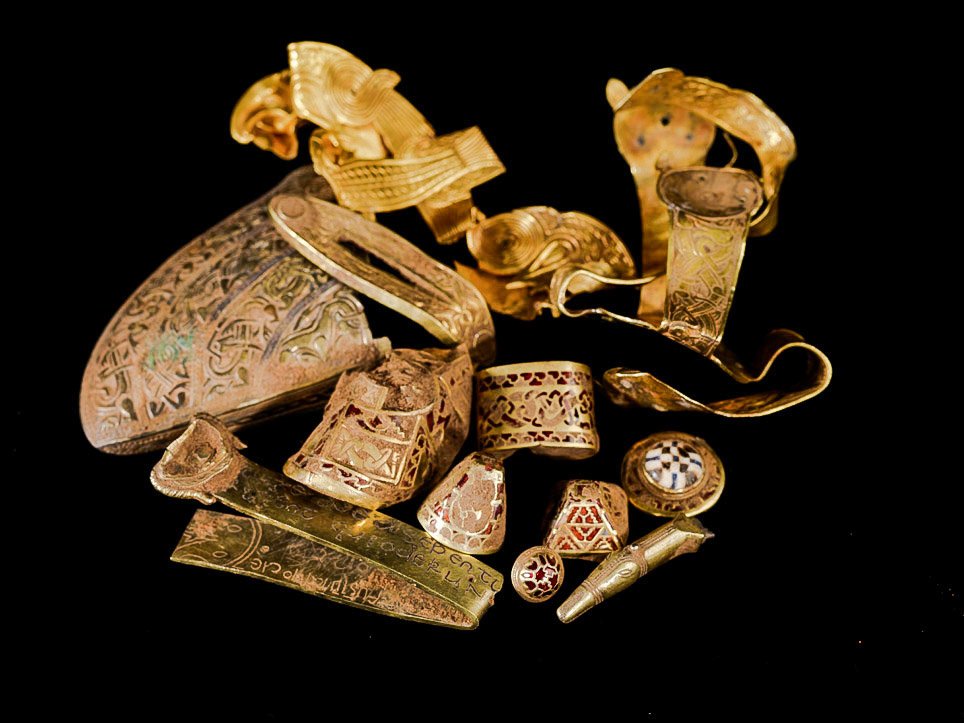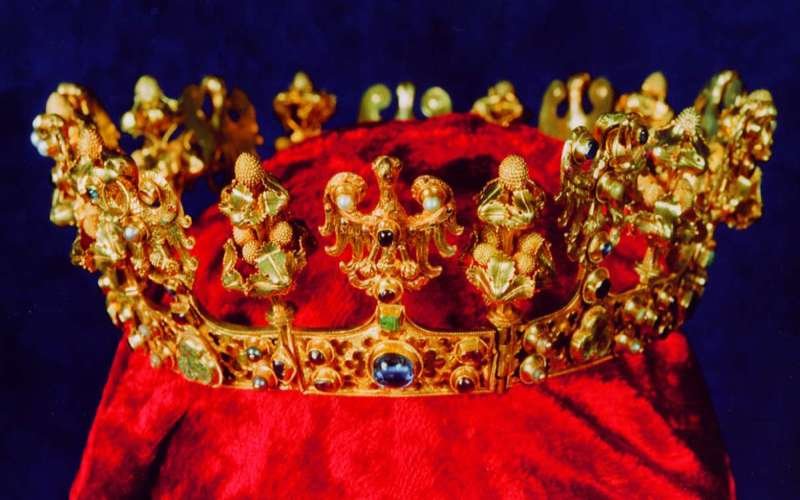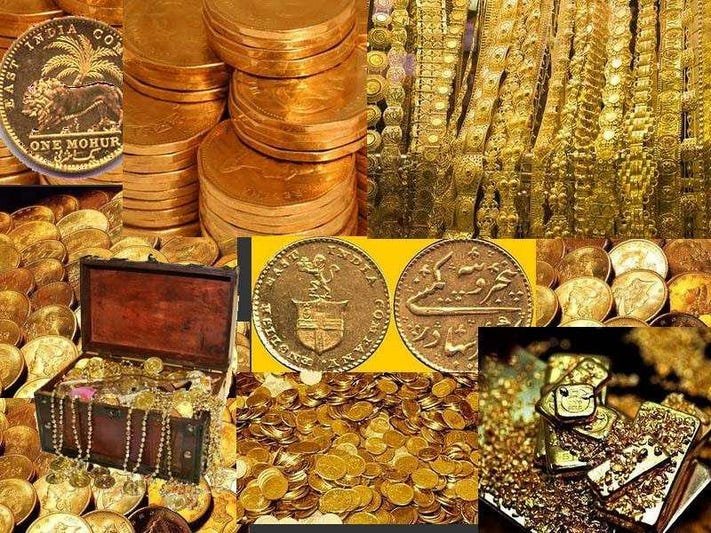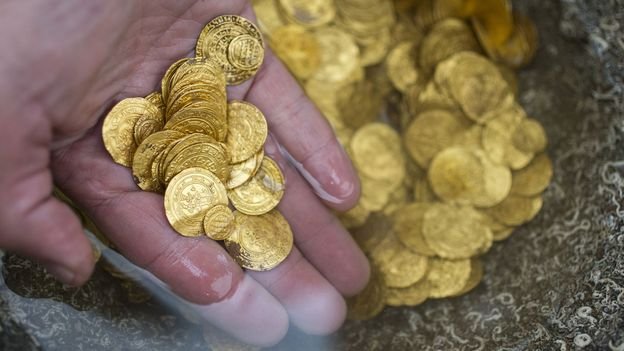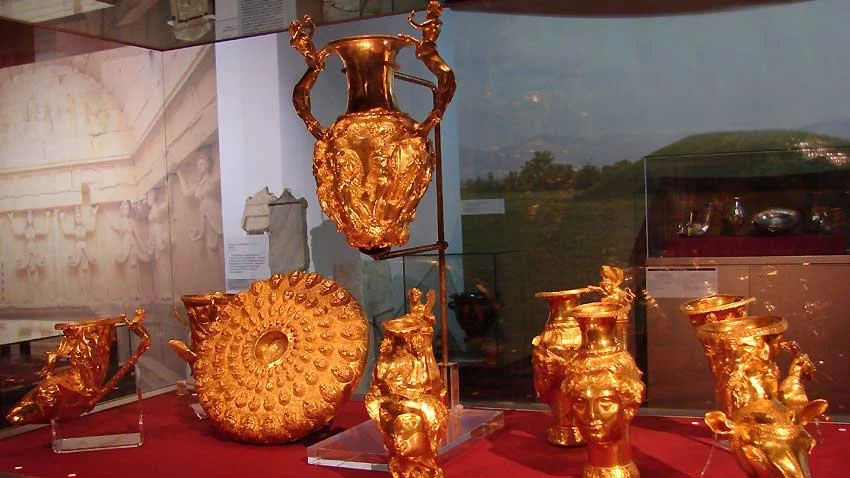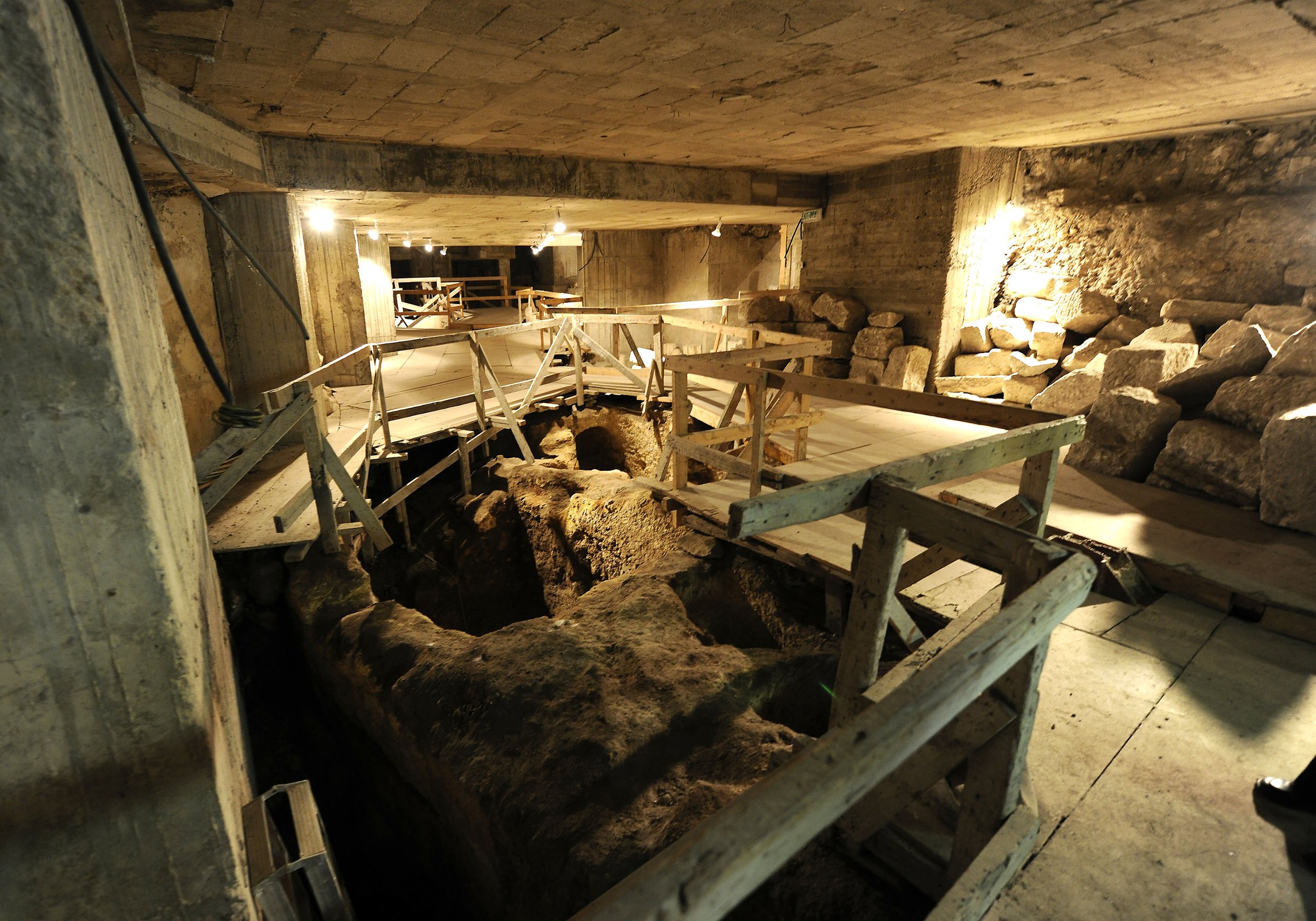A team of volunteer archaeologists are digging at a ruined Roman settlement in the U.K. At the site, the group focus their efforts on an ancient latrine, working around the area to see what they can uncover. Then, as the archaeologists excavate around the drain of the centuries-old toilet, they hit paydirt. In a most unexpected place, they find a clutch of incredible artifacts that may yet shed new light on Roman history.
A Mysterious 500 000 Year Old Artifact Discovered by Accident
Every year archaeologists increasingly find artifacts that are difficult to explain! Some of them are not only difficult, sometimes even impossible. Indeed, thousands and millions of years ago, our ancestors did not know how to produce metal, they did not have modern technologies that would allow them to make accurate calculations, they could not even observe themselves from a bird's eye view. But this did not stop them from producing the most complex artifacts that we find today.
15 Hidden Treasures That Have Been Found (Plus 10 That We're Still Searching)
This article will highlight the numerous gems that have been discovered while posing no risk to the finders or those still at large.
Humans have long been attracted by the idea of precious objects hidden in various parts of the world waiting to be found by the right person, from ancient mythology like Jason's quest for the Golden Fleece to literary tales like Treasure Island. The success of the Indiana Jones films in the 1980s and subsequently National Treasure in the early 2000s contributed to this sense of adventure. Although though the majority of these treasures are made up, individuals have nonetheless searched for what they believe to be real-life treasures, including the infamous Lost Dutchman's Gold Mine and the magnificent Seven Cities of Gold. Many people have dedicated their entire lives to looking for these, with some even dying in the process.
The Lake Toplitz treasure in Austria is an example of this. The Third Reich is said to have dropped a large amount of money there around the conclusion of World War II, but all that has been discovered so far is a collection of fake British currency. The Austrian authorities restricted further exploration of the area as a result of treasure hunters risking their lives by diving deeper into the lake in search of the "Real treasure." Yet in this post, we'll highlight some of the undiscovered jewels while also showcasing the different finds that have been made without causing harm to the discoverers.
25 Found: The Ophel Treasure
On September 9th, 2013, a respectable-sized treasure was discovered in Jerusalem during an archaeological dig. The Ophel treasure, so named because it was discovered near the famed Temple Mount hill, was made up of 36 gold pieces, including a medallion with a menorah image on it (as seen above), two additional medallions, a coil, and a few pendants that may have been decorations for a Torah scroll.
Collectively, these artifacts are from the late Byzantine era and may have been left behind when the Persians captured Jerusalem in 614 CE (or AD).
24 Still Searching: El Dorado
Spanish for "Golden One," it was initially made known to Europeans in the 1500s as they traveled across Central America in search of Lake Guatavita, the claimed source of this fabled riches.
El Dorado turned out to be a religious ritual carried out by the leader of the local Muisca tribe, who covered himself in gold and tossed various gold objects into the lake to thank the Gods.
The Spaniards then attempted to drain the lake in 1545, during which time they retrieved some gold, and again in 1911, many centuries later.
23 Found: The Saddle Ridge Hoard
According to Dan Whitcomb of Reuters, a California couple was walking their dog one day in April 2014 when they discovered a metal can coming out of the ground. After digging out the can, which was rusted from age and contained a sizable hoard of gold coins, they were able to open it.
Soon after, the couple discovered comparable cans on their land that contained coins from the 19th century; however, it is unknown why they were buried there or who was responsible.
In any case, the coins were then given the moniker "Saddle Ridge Hoard" and taken to Kagin's currency firm.
22 Found: The Frome Hoard
This extensive collection of Roman coins, which is named after a town in Somerset County, England, was unearthed in 2010 by a man by the name of David Crisp. He was a metal detectorist by trade, and when his detector went off, he discovered this hoard.
He dug up 21 coins, then went further and discovered a two-foot-tall pot before contacting the authorities.
The collection, with an estimated worth of 320,250 pounds, was eventually handed to the Museum of Somerset after it was discovered that the pot included additional coins, increasing the total number to 52,503. (or about 409,797 dollars).
21 Still Searching: The Florentine Diamond
This Pink Panther diamond is a real-world example (from the original film with Peter Sellers and not the Steve Martin remake). According to Reader's Digest, this unique diamond, which weighs 137.27 carats, was originated from India and eventually passed via the Medici family before being acquired by the Imperial House of Austria.
But after World War I broke out, the Imperial Family was had to flee, and they took the diamond with them to Switzerland, where they never again heard of it.
As a result, there were many different explanations on how it vanished, including theft and fracture.
20 Found: The Harrogate Hoard
This hoard was also uncovered with metal detectors near the English town of Harrogate, in the county of North Yorkshire, three years before the Frome Hoard. David and Andrew Whelan, a semi-retired businessman and his son, were the two who discovered it.
In addition to the 617 silver coins, the trove also included different ornaments and jewelry, including necklaces, one of which was made entirely of pure gold.
The treasure is thought to have belonged to a wealthy Viking who resided in the Kingdom of Northumbria during the tenth century because the coins originate from several locations.
19 Found: The Ringlemere Hoard
This group of Anglo-Saxon artifacts was discovered around the turn of the century, specifically in the year 2001, at a farm near Kent County in England by amateur archaeologist Cliff Bradshaw, who discovered them using a metal detector.
He found a brooch and a cup with a height of fourteen centimeters among the things.
Unfortunately, it appears that a plough severely crushed its sides. Bradshaw notified the authorities, and the trove was then transported to the British Museum. A burial site from the Early Bronze Age was discovered once the region had been fully excavated.
18 Still Searching: The Max Valentin Owl
A man who went by the nickname "Max Valentin" produced a treasure-hunt book in the early 1990s called Sur la trace de la chouette d'or (or On The Trail Of The Golden Owl in English).
He promised to offer the finder of a golden owl statue concealed in the French countryside one million Francs, or roughly $992,216, as a reward.
Even though the book offered a number of hints as to the owl's whereabouts, no one has been able to determine its exact location to this day, which was made more difficult by the author's demise in 2009.
17 Found: The Cuerdale Hoard
There were some bridge builders working close to the river that flows through the Cuerdale region, which is home to the titular Cuerdale Hall and no other communities at the time, around 1840. (though back then it was a small town).
They discovered a lead box here, and when they opened it, they discovered a significant Viking treasure that contained, according to BBC History, some 8,600 pieces, including silver coins, jewelry, and ingots.
Following their discovery, the men stole one coin each for themselves before giving Queen Victoria the remainder, which eventually led to some of the coins ending up at the British Museum.
16 Found: The Hoxne Hoard
A hammer was misplaced by a British farmer named Peter Whatling in the early 1990s. This prompted him to invite a friend over, whose metal detector turned up more than just the hammer.
The two men discovered a variety of silverware, jewelry, and coins made of silver and gold within an oak-wood trunk.
These artifacts are listed in the Ancient History Encyclopedia as being from between the Fourth and Fifth Centuries, which suggests that they are Roman in origin. As archaeologists conducted additional excavation in the region and discovered Roman bowls and ladles, this was further supported.
15 Some found: The Confederate Gold
There was unaccounted gold worth millions of dollars after the Civil War ended. Though a few facts have emerged, numerous historians and treasure hunters have conjectured about the reason why.
For instance, when the Confederacy's president was compelled to leave Richmond, Virginia, in April 1865, he boarded two trains bound for the south, one of which was carrying the Confederate States' entire treasury.
The rest of the gold was supposedly lost after being placed in various locations for storage, leading some to believe that it eventually ended up in Lake Michigan.
14 Found: The Staffordshire Treasure
This treasure trove, which is thought to be worth 4.1 million dollars, was discovered in 2009 by a man by the name of Terry Herbert using a metal detector in a plowed field close to Hammerwich Village in Staffordshire County, England.
Here, he discovered a variety of Anglo-Saxon-made objects, from weapons to religious artifacts.
They are believed to date from the eighth century and possibly earlier, when England was divided into various tiny kingdoms, including Mercia, Kent, and Northumbria, to mention a few, though archaeologists have not been able to determine a precise date of inception.
13 Found: The Środa Treasure
A few structures in the Polish town of Roda lska were going to be demolished in the middle of the 1980s when some intriguing items were discovered. The first gift was a silver vase containing 3,000 coins; other items included a golden crown (as seen above), a ring with an insignia in the form of a dragon head, and several others.
Several archeologists have conjectured about the origins of these artifacts and their true worth going back to the Fourteenth Century. Yet, the most widely accepted theory is that Charles IV of Bohemia used them as pawns.
12 Still Searching: The Awa Maru Treasure
When America attempted to send supplies to its POWs in Japan toward the conclusion of World War Two, this ship found itself in the midst of a complicated scenario. Yet, in return, they were required to permit Japanese ships to get past American naval defenses without bombing them.
Thus, they made attempts to smuggle out a number of items to win the war, including its smartest individuals historical treasures and other assets that are today valued at 5–10 billion dollars.
However, the Awa Maru was torpedoed and sank into the water close to China as a result of a communication blunder.
11 Found: The Sree Padmanabhaswamy Treasure
Get a load of this if you think that name is a mouthful! The archeologists and firefighters who were hired to inspect this holy temple found across several underground rooms that contained valuable objects that were estimated to be worth billions of dollars during the inspection that the Supreme Court of India had ordered in 2011.
They can include gold coins from the East India Company, bags of diamonds, and more.
Notwithstanding some claims to the contrary, it is highly disputed that the worth of this treasure exceeds that of the riches in the Tirumala Venkateswara Temple to the north.
10 Found: The Caesarea Treasure
There have been numerous jewels found in the harbor of this location, which bears the name of an ancient city on the Israeli coast that is now a national park.
The first significant one occurred in 2015 when two divers found about 2,000 gold coins from the tenth to the twelfth centuries.
Then, a year later, two more divers discovered the wreckage of a sunken ship and unearthed numerous bronze statues and other what look to be Roman artifacts (as shown above). Nevertheless, in particular, the reign of Emperor Constantine, for whom the city of Constantinople was called (306-337 AD).
9 Found: The Panagyurishte Treasure
At the titular town in Bulgaria, three brothers were looking for clay in 1949 when they discovered various items made of pure gold. These artifacts, which total more than 13 pounds in weight and date to the Fourth Century BC, were carved into drinking horns (like the one shown above), unique vases, and decanters.
Whilst the title "Thracian" was a designation that the Ancient Greeks applied to these people, it is thought that these objects were utilized for religious purposes, particularly by the Thracians who were in the region that would become Bulgaria at the time.
8 Found: The Bactrian Gold
This collection, which was discovered during the excavation of the Tillya Tepe site in Afghanistan, also known as the Bactrian Gold site, includes more than 200,000 gold jewelry that were retrieved from burial mounds that date from the First Century BC to the First Century AD.
Also, the products were made in a variety of nations, including India, China, and Greece.
The collection was discovered in 1978, but after multiple instances of looting at Afghanistan's National Museum during the Afghan-Russian conflicts, it was assumed to be gone. Since then, the majority of the artefacts have been found and are now housed in different museums.
7 Still Searching: The Oak Island Money Pit
This elusive treasure off the coast of Nova Scotia, Canada, was first found in 1795, according to the Huffington Post, and it has captured the interest of treasure hunters for generations.
It all started when Daniel McGuinness, a teenage guy, was enticed to the island after he allegedly saw lights and fell into a hole.
He and his companions began exploring it in the hopes of unearthing hidden wealth but ultimately came up empty-handed. Yet, this didn't stop others from trying to pick up where they left off, digging a bigger hole in the process and making the original essentially disappear.
6 Found: The Siebenberg House Artifacts
This home, which is in Israel's Jewish Quarter, has been converted into a sort of museum after its owner, Theo Siebenberg, discovered a cache of numerous artifacts with important archeological significance. Following the infamous Six Day fight, Siebenberg purchased the home in 1970. During the next 18 years, he dug beneath it to disprove the doubters' claims that valuable ancient relics were hidden there.
He discovered burial vaults that date back to King Solomon's reign, 3,000-year-old ritual baths called Mikvahs (or Mikvehs), and several apartments carved into the rock.
5 Found: The Hanuman Dhoka Palace Treasure
This historic palace was being renovated in Kathmandu, Nepal, in 2011 when the workers unearthed a remarkable find. Three boxes hidden in a storage that hadn't been opened in many centuries contained 80 kilos of silver decorations and three kilograms of gold jewelry, respectively.
These jewels reportedly date back to the Malla Kings' control over Nepal beginning in 1200 AD.
Their reign came to an end in the late 1700s when King Prithvi Narayan Shah assumed control and founded the Kingdom of Nepal, which was followed by a time of prosperity and turbulence.
4 Still Searching: The Monterrey Loot
The Peloncillo Mountains and Skeleton Canyon are located on the border of Arizona and New Mexico. There are allegedly many hidden treasures here, but the Monterrey Loot is one of the most well-known.
According to Listverse, it was named after a Mexican city that a band of robbers raided towards the close of the nineteenth century.
The robbers returned to the United States, carrying 39 gold bars, one million dollars' worth of coins and gems, as well as a number of Catholic antiques.
3 Still Searching: The Lima Treasure
The wealth the Spaniards had amassed after conquering the Incan Empire in the sixteenth century was taken and kept in the Peruvian capital of Lima. According to NOVA Online, this comprised a wide range of gems, religious sculptures, gold bars, and silver bars, all of which were worth at between 12 and 60 million dollars at the time.
Sadly, the most of it was taken by British pirates who allegedly buried it at Cocos Island before being captured by the Spaniards, while the captain and first mate who were still alive disappeared on the island.
2 Still Searching: The Poverty Island Treasure
In addition to the Confederate Gold, Lake Michigan is the location of another ostensible treasure that is close to Poverty Island, which has a depressing lighthouse. However, there are several tales about the origin of this treasure, ranging from a French ship carrying gold that may have belonged to Napoleon Bonaparte the Third being scuttled by pirates to belonging to James Strang, who may have lost a lot of gold in the lake after his religious colony on Beaver Island failed.
Regardless of where it came from, the stated value of this gold has been calculated to be 400 million dollars.
1 Still Searching: The Forrest Fenn Treasure
This treasure, which bears the name of the man who hid it after beating a terminal disease, is said to be hidden someplace in the Rocky Mountains. The contents of the chest, which is locked inside, are unknown. According to Forrest Fenn's acquaintance, it contains a variety of gold artifacts, including coins and nuggets, which were among the millionaire and art collector's prized treasures.
Despite being constructed by Fenn and his friend in the late 1980s and being buried in 2010, many individuals have been looking for the chest using the hints offered in books that Fenn has published.
10 Most Amazing Ancient Finds That Change History
In this video we will discuss about the unforgettable search for ancient artifacts and amazing megalithic structures. Throughout the history of archeology, many ancient artifacts have been unearthed from the earth, the most interesting of which, as a rule, are exhibited in museums. The vast majority of artifacts found are sent to storerooms and scientific repositories (because there are so many of them that they simply do not fit into museums). Basically, insignificant or poorly preserved finds are sent to the storerooms. The study and restoration of some of them sometimes stretch for decades.
But there are those that are never shown to the general public, and experts prefer not to mention them. As a rule, scientists confidently attribute such artifacts to remakes, and perhaps most of them are such, but not all. Otherwise, science would have smashed all anti-scientific (alternative) theories long ago, which, with all the diligence, it has not yet been able to do
57 Finds of Archaeologists from Ancient Egypt and Other Countries of Our Planet
Every person on our planet has heard about Ancient Egypt - the mysterious pyramids, mystical pharaohs, many mummies and other artifacts tell us about the unique civilization of the ancient world. But those who are fond of archeology and our ancestors are well aware of other unique civilizations of the past. Archaeologists all over the planet are finding ancient artifacts and structures that amaze our imagination. In this video we have collected 57 archeological finds that will amaze you!
This is how Egyptians looked before the Pyramids were built
Look at the face of a person who existed in Egypt thousands of years before to the construction of the pyramids. The 30,000-year-old human remains found in the Nile Valley have recently been used to rebuild facial features, offering a highly personal view of ancient Egypt.
Brazilian archeologist Moacir Elias Santos and 3D artist Ccero Moraes collaborated to create the facial reconstructions. The two used a nearly complete skeleton that was discovered in 1980 at the ancient Egyptian site of Nazlet Khater 2 as the basis for their investigation.
The skeleton belonged to a young man of African descent who was about 165 cm (5 feet 4 inches) tall, possibly in his late teens or early twenties.
Because to the skeleton's extremely fractured bones and the relatively primitive state of radiocarbon dating technology at the time, early attempts to date the skeleton were unsuccessful. Thankfully, a stone axe was discovered next to the remains, which was between 35,000 and 30,000 years old.
According to the study, the skull can be regarded as "modern," indicating that this person may have been able to think similarly to people today. They do point out, however, that the remains do have some "archaic" traits, most notably a broader jaw than contemporary Homo sapiens.
The missing pieces of the remains were subsequently put back together utilizing a variety of scientific methods after the photogrammetry imaging technology had successfully captured the contour of the head. They had to figure out where and how the soft tissue would rest on their skull after assembling an approximate complete skull.
As facial reconstruction from a skull alone is not a precise science, some artistic license is required. This is due to the fact that the skull's structure can only offer a limited amount of information on how soft tissue like muscle and fat would actually appear on a person's face.
Two final photos were produced as a result, "one more subjective and artistic and the other more objective and scientific," according to the team. The "artistic" example has hair, a light beard, and expressive eyes whereas the "scientific" image is more of a raw bust.
The researchers write in their paper, "Although it contains speculative elements about the individual's appearance, as it is a work that will be presented to the general public, it provides the necessary elements for a complete humanization, which is very challenging to achieve only with exposure of the skull and deficient in the objective image in grayscale with eyes closed.
This individual would have had a hunter-gatherer lifestyle and been only equipped with brainpower and stone implements. Permanent towns didn't begin to form throughout Egypt until 6000 BCE, or about 25,000 years after this man lived.
Of all, this was the place where one of the most magnificent ancient civilizations, recognized for its extremely complex culture and architectural achievements, was born. Although the origins of Ancient Egypt's technological prowess are frequently presented as a deep mystery, scholars have recently begun to develop a better understanding (no, it wasn't from aliens).
Listen to the sounds of historic languages, including Egyptian and Aztec
Listen to 14 ancient languages that will take you back in time, from the Ancient Egyptians to the Sumerians, Romans to the Maya, or even the Vikings and Celtic. These languages provide a little glimpse into the past and the cultures that were once present, albeit many are no longer spoken, thus we may not know how they were pronunced.
Legendary Bigfoot Footage AI Stabilized, Clearly Showing What It Is
Over the years, Bigfoot has been "seen" numerous times. Usually, it's a bear or a person dressed as a gorilla. But occasionally, just occasionally, it turns out to be a man doing shamanic rituals in the woods while covered from head to toe in animal skin.
The Patterson-Gimlin film, one of the most well-known clips, has a human walking through the Six Rivers National Forest and turning briefly to look at a camera filming at an unknown pace.
The tape was allegedly taken on October 20, 1967, by Roger Patterson and Robert Gimlin, who claimed to have encountered the hairy creature hiding next to Bluff Creek. The two claim that they pursued the figure before capturing it on camera as it continued to walk and occasionally turned to face the lens.
Despite being largely rejected as a fake by the scientific establishment, the footage is nonetheless well-liked by Bigfoot enthusiasts and conspiracy theorists. You might be perplexed as to why the movie needs to be stabilized considering that, absent camera shake, it would essentially look like a person wearing an ape suit going down the street.
The video has already been the subject of similar examination. One researcher, a general Bigfoot believer, claimed to have discovered a fastener of some sort on the creature's waist in 1999 after photocopying and enlarging frames from the tape.
After concluding that this footage was phony, Cliff Crook, who continued to believe in the existence of Bigfoot, told Wired in 1999, "It presumably snapped loose and hanged from the fur." "That is a fraud. Why would Bigfoot wear a buckle on his belt?"
The study of hairs that different people have claimed to have obtained from a Sasquatch is one of the most scientific investigations into Bigfoot allegations. These were discovered to be mostly from dogs, other well-known animals, including bears.
At a location near Buckingham, a Mesolithic stone mace head was discovered during excavation
While excavating a site close to Buckingham, archaeologists came up a lovely Mesolithic stone mace head. Cotswold Archaeology completed the work as a component of the HS2 project.
The mace head is made of quartzite pebbles and measures about oval (105 mm x 74 mm x 40 mm) with a central hourglass opening (approximately 35mm-20mm in diameter). The mace head has light impact damage on both ends, which points to its past employment as a percussive instrument.
The modest wear at the narrow point of the central perforation shows that the item was hafted. The central perforation may have been produced by pecking, as seen by the small chip marks that surround it, rather than drilling.
These Mesolithic items adopt the shape of the raw material, unlike later Neolithic mace heads that are sculpted to achieve a certain shape. Similar pebble mace heads have been discovered in Britain, particularly at Oakhanger in Hampshire and Eton Rowing Lake in Berkshire, and they are believed to be Mesolithic in origin.
It is believed that Mesolithic hunter-gatherer activity was centered in resource-rich locations like woodlands and along watercourses, with the majority of the known sites being situated on drier, rising territory. The location of the site was on a River Great Ouse tributary.
In a post-medieval quarry fill that had obliterated a winding trench, the mace head was discovered. It's probable that this ditch was formerly a portion of a prehistoric ring ditch because the mace head came from a truncated internal deposit.
Two other ring ditches, possibly indicating Bronze Age round barrows, have been discovered nearby using aerial photography, and two additional ring ditches as well as Bronze Age cremation burials are known from the neighborhood.
The Sedeinga Pyramids
are a collection of 80 little pyramids built on the west bank of the Nile valley, close to Sedeinga, Sudan, between the second and third cataracts.
During the Kingdom of Kush, an ancient African state in Nubia that included the regions between modern-day central Sudan and southern Egypt, Sedeinga served as the region's capital.
Three phases of Kushite development occurred in this area during antiquity. The first, which was Nubia's first centralized state with a native style of building and burial practices, had its capital at Kerma (2600 to 1520 BC).
The last kingdom was centered at Mero, while the second monarchy (1000–300 BC) was centered at Napata (300 BC to AD 300). The traditions and funeral rituals of Ancient Egypt had a significant influence on both later Kingdoms.
Sedeinga connected the Kingdom with Middle Egypt directly while being cut off from the majority of Kush and possibly acting as a commerce hub along an old trade route.
The pyramid site has tens of thousands of burial chambers together with the bases of 80 late Meroitic pyramids. The greatest pyramids are 22 feet wide at their base, while the smallest pyramid, which was probably built for a child's burial and is only 30 inches wide, is much smaller.
The Sedeinga pyramids were built primarily for the rich elite and showcase architectural details that have a wider Egyptian influence, such as capstones that show birds or lotuses emerging from solar discs. Pyramid burial was often reserved for royalty.
Egypt's 18th dynasty had dominion over Nubia all the way down to the fourth cataract on the Nile River. At Sedeinga, a temple was built in honor of Queen Tiye, the pharaoh Amenhotep III's consort who was said to have Nubian ancestry. This temple served as the feminine counterpart to the enormous temple Amenhotep III erected in Soleb nearby for Amun and his own god figure.
See Vivid Zodiac Sign Paintings from an Ancient Egyptian Temple
The Ptolemaic era reliefs have just undergone restoration after being covered in soot and filth previously.
The zodiac, a belt-shaped region of the sky typically split into 12 astrological signs, is depicted in a number of ceiling murals that have been restored by archaeologists excavating the ancient Egyptian Temple of Esna. The artworks, which are Ptolemaic in date (305–30 B.C.E. ), add to the body of evidence that suggests the Greeks introduced the Egyptian zodiac tradition.
According to Christian Leitz, an Egyptologist at the University of Tübingen in Germany, "Representations of the zodiac are exceedingly rare in Egyptian temples." The zodiac was first used in Babylonian astrology, and it wasn't until Ptolemaic times that it first appeared in Egypt.
On earthenware and sarcophagi from the Ptolemaic era, representations of the zodiac signs and their corresponding constellations can be found. Yet, decorations for temples hardly ever feature the motif. "Apart from Esna, there are only two entirely preserved versions left," writes Daniel von Recklinghausen, a fellow Egyptologist from Tübingen, in the statement, "both from the Dendera Temple Complex on the West Bank of the Nile River."
Leitz claims that the Esna zodiac is almost exactly like the one that is used today in an interview with Live Science's Owen Jarus. Except from few depictions in the placards, there is no difference, he claims.
According to Nevine El-Aref of Ahram Online, in addition to the 12 signs, the Esna reliefs also depict Jupiter, Saturn, and Mars as well as the "seven arrows" of Sekhmet and constellations that the ancient Egyptians used to calculate time. Some recently restored pieces of art feature crocodiles, snakes, and other imagined animals like a bird with a crocodile's head.
Researchers from Tübingen and the Egyptian Ministry of Tourism and Antiquities joined forces to start the restoration project in 2018. In order to restore ceiling frescoes, column inscriptions, and other artistic components to their former appearance, researchers painstakingly removed layers of soot, dust, and filth.
In a 2022 statement describing freshly undiscovered frescoes of the vulture goddess Nekhbet and the serpent goddess Wadjet, von Recklinghausen claimed that the temple's entire spectrum of images was "unique in its wealth of figures and the degree of preservation of the colors."
The zodiac is not Esna's first celestial-related discovery; Esna is about 40 miles south of Luxor. In 2020, the crew came across inscriptions that showed the names of various constellations in ancient Egyptian. According to Michelle Starr of Science Alert, Mesekhtiu was the name of the Big Dipper while Sah was the name of Orion. Experts may be able to connect the name of a hitherto undiscovered constellation, Apedu n Ra, or "the geese of Ra," with the appropriate zodiacal sign by using the recently repaired ceiling murals.
The exact origins of the zodiac signs or the profession of astrology are unknown to historians (divination based on the movement of the stars). The Venus tablet of Ammisaduqa, one of the earliest objects connected to celestial divination, dates to the Neo-Assyrian era, roughly between 911 and 612 B.C.E. In 2018, Olivia B. Waxman reported for Time that the item traced the movement of Venus and "is one of the first pieces of what's been called Babylonian planetary omens."
As the Greeks came to rule the Mediterranean, the 12 signs denoting the division of the night sky went from Mesopotamia to Greece. Following Alexander the Great's conquest of Egypt in 330 B.C.E., the two cultures exchanged their knowledge of the stars, with the Egyptians debating the yearly movement of the sun and the patterns that make up constellations and the Greeks introducing the idea of zodiac signs.
According to Sten Odenwald, NASA's director of STEM resource development, "There must have been a lot of exchange that brought the Greeks on board with the idea of divination using planets," Time reported in 2018. "And they worked out a lot of the principles for how this could work because they were deeply interested in mathematics and logic."
The Dendera Zodiac, which is presently kept at the Louvre in Paris, is undoubtedly the most well-known astrological relic from ancient Egypt. The bas-relief, which is thought to date to circa 50 BCE, features the 12 constellations of the zodiac, five planets, and both a lunar and solar eclipse.
The Strawberry's History
The pairing of strawberries and cream has an unmistakably English flavor. Consider Pimm's and somewhat rainy picnics. Perhaps the reason for this relationship is that the combination has been a mainstay of Wimbledon since the first competition there in 1877. In truth, Thomas Wolsey (or, rather, his cooks) served Henry VII the original version of this summery delight at a feast at Hampton Court palace in the early sixteenth century, which is when it first became popular. But, this gloss of "Englishness," as opposed to the exotic pineapple, may have meant that the strawberry's colonial origin was previously unrecognized.
Strawberries consumed by the Tudor court and those found on store shelves now are altogether different species. The strawberry variety we know today, however, is the result of a long history of crossbreeding strawberry varieties that were harvested from all over the Americas. With war, slavery, espionage, and the extractive colonial history of botany, the history of the strawberry is thus a history of empire. In particular, the French, British, and Spanish Empires are responsible for the flavor of the "modern" strawberry.
Throughout Europe, there have always been many strawberry kinds, but it's possible you've never tried any of them. Three types in particular are referred to as "wild or woodland strawberries" (Fragaria vesca, Fragaria moschata, and Fragaria viridis). From the Neolithic era, humans have consumed these types, according to archaeological evidence. Because strawberries are said to have grown when Aphrodite's tears mixed with the blood of the deceased Adonis and fell to the ground, strawberries were later frequently consumed in Ancient Rome during festivities honoring Adonis, the mortal lover of the goddess Aphrodite.
The woodland strawberry was also significant symbolically in medieval and early modern Europe. Strawberries were occasionally used as emblems in illuminated manuscripts during the Middle Ages, with the three-part leaf serving as a reminder of the Holy Trinity. The five petals of its white flower represented Christ's five wounds, and the scarlet fruits, which pointed downward, stood in for drips of his blood. Strawberries with symbolic meanings can be found throughout Shakespeare's works and are frequently used as a virginity symbol. Charles V, King of France from 1364 to 1380, cultivated 1,200 strawberry plants in his royal garden because he loved the fruit. 'Water of strawberries' was once used to cure Henry VIII's famed leg ulcer, indicating the fruit may also be used medicinally.
Strawberries of the Fragaria viginiana kind can be found all across North America. They are considered to be a sacred fruit by numerous Indigenous communities in the area. The Cherokee claimed that the Creator had brought together the First Man and the First Woman using a strawberry. The Oneida employ strawberry water for therapeutic purposes, just like Henry VIII's physicians. Since June is when strawberries start to ripen, several tribes refer to it as the "Strawberry Moon."
When the French and English empires invaded Turtle Island (the name for North America used by numerous Indigenous people in the northeast) in the sixteenth century, they both claimed to have "found" Fragaria virginiana. These strawberries from North America were unusually tiny and tasty. At his family's property in Shadwell, Virginia, Thomas Jefferson made a comment about strawberries that were probably picked by slaves, saying that "100 [strawberries] fill half a pint."
The strawberry seems to have been "claimed" early by the French colonizers. First European to cross Turtle Island's interior, Jacques Cartier, spoke about "huge patches of strawberries along the great river [St Lawrence] and in the woods" in 1534. Reports indicate that these North American strawberries first appeared in France in the first half of the sixteenth century. No one can definitively be identified as the person who transported these specimens to France, however the first cataloged mention dates from 1601, in the garden of Jean Robin in Paris.
Moreover, strawberries in the Americas were "discovered" by the British Empire a bit after the French. The early English colonists who settled there wrote about strawberries in a number of their works. For instance, Thomas Hariot, the notorious colony of Roanoke Island's scientific advisor, stated of this new strawberry variety: "They are as great as those we have in English gardens" (1588). He had sent seeds back to England a few years ago, but the resulting plants had had difficulty surviving. Similar to this, George Percy mentioned the fruit in his essay on the 1607 establishment of Jamestown.
The founder of Rhode Island, Roger Williams, said in 1643 that the natives baked strawberry bread but that "the English have exceeded and make good wine." Fragaria virginiana was improved upon in 1672 by Robert Morison, an Oxford University botanist, who created a clone that thrived in the English environment. Morison studied in Paris with Vespasien Robin after earning his doctorate in western France; Robin was also the author of the first description of Fragaria virginiana, published in 1624.
Fragaria chiloensis, a strawberry native to Chile, is much larger than the types previously mentioned, yet it may be less sweet, similar to Fragaria viginiana. The reports of the invasion of Wallmapu contain descriptions (the ancestral territory of the Indigenous Mapuche). The history of this variety is strongly related to that of the Arauco War, one of the longest wars ever and one of the few in which the Spanish Empire, a European colonial force, fought an Indigenous people.
Indigenous peoples in Wallmapu also relied heavily on the Chilean version of the fruit as a source of food. Given that the Mapuche and Huiliche languages, Mapudungun, have distinct words for both wild strawberries (llahuen, lahuene, or lahueni) and cultivated strawberries (Fragaria chiloensis), it is likely that both groups cultivated Fragaria chiloensis (quellghen). However, Pedro de Valdivia, the first Spanish colonizer of Chile, used a new phrase to characterize the "new" fruit of the New World at the start of the Spanish conquest of Wallmapu in 1542. Valdivia referred to the Chilean strawberry as a frutilla, even though the word for strawberry in European Spanish was and still is fresa (Spanish for little fruit). In most of South America, the word "strawberry" has stuck and is still used to describe the fruit.
Similar to Fragaria virginiana, Fragaria chiloensis is compared favorably to European types in descriptions. According to Alonso de Ovalle, a Jesuit priest and historian of the Arauco War, "[t]hey are very different from those that I have seen here in Rome, in terms of the flavour as with the smell and in terms of quantity, because they grow as large as pears, although they ordinarily are red, there are also, in Concepción [a town in southern Chile], white and yellow ones."
The strawberry's rhetorical use to justify enslaving Indigenous peoples by emphasizing their land's fertility is one of the most disturbing aspects of its history. During a Mapuche and Huilliche uprising in 1598, the Spanish invaders experienced a string of grave setbacks that the latter dubbed "The Fall of the Seven Cities" (1599 – 1604). Chilean soldiers were compelled to reconsider their military plan. The Governor of the Captaincy General of Chile despatched soldier Alonso González de Nájera (? - 1614) to Spain in 1607 to lobby King Philip III for fresh tactics and reinforcements.
Nájera spends a substantial amount of words extolling the merits of the Chilean strawberry in his 1614 narrative of the conflict, which is essentially a long justification for the enslavement of the Mapuche. Nájera may have used these in-depth explanations of the strawberry's extraordinary flavor, aroma, and appearance to persuade King Philip III that the conquest of Chile was still worthwhile due to the region's fertile soil. His cries were disregarded, however, in favor of a plan that did not prioritize slavery.
In the strawberry tale from a century later, the French Empire reappears. King Louis XIV assigned a spy called Amédée-François Frèzier in 1712 to research the defenses of the Spanish possessions in South America. Coincidentally, his last name is derived from the French word for strawberry, fraise. He appeared to be a businessman or merchant while actually being a lieutenant colonel of Army Intelligence in order to spy on Spanish defenses. Frèzier, though, captured more than just defenses. He also wrote extensively about botany, notably the strawberry, and indigenous customs.
In 1714, he returned to Marseille with strawberry specimens; five of the twelve plants had made it to France. But while in France, they flourished in growth but bore no fruit. Only female plants, which require pollination to produce strawberries, were provided by Frèzier. Frèzier originally categorized the fruit as Fragaria chiliensis in 1717 to reflect its Chilean origins; however, in 1753 the name was changed to Fragaria chiloensis to honor the Chilean island of Chiloé, where strawberries are a common crop.
Botanists quickly discovered, nevertheless, that Fragaria chiloensis could be mated with Fragaria muschata or Fragaria vesca (varieties of woodland strawberry). Fragaria chiloensis and Fragaria virginiana were successfully crossed by French botanist Antoine-Nicolas Duchesne in 1765, which is considered to be the most significant crossbreeding event. Because of the flavor of another New World fruit, the pineapple, this cross was given the name Fragaria x ananassa. Fragaria x ananassa rapidly became the preferred variety throughout Europe and continues to be so today since it now combines the size of the Chilean type with the sweetness of the North American variety.
Hence, when you eat a strawberry and comment on its sweetness or size, you are echoing the views of centuries' worth of warriors, spies, and scientists from three different empires. The strawberry serves as a visible reminder of how colonialism has influenced even the most commonplace—or superficially British—aspects of daily life.
Rare "devil fire" worms found in Japan are strikingly similar to prehistoric demons, according to studies
Scientists in Japan have identified three species of sea worms, giving them the names of mythical demons because of their eerie glow.
In Japan, scientists have discovered three new species of uncommon glow-in-the-dark worms that bear a "striking similarity" to demons mentioned in legend.
The three newly discovered species, Polycirrus onibi, Polycirrus aoandon, and Polycirrus ikeguchii, are members of the bristle worm family of creatures that are often discovered in the shallow waters of Japanese rivers and streams. On March 29, researchers in the journal Royal Society Open Science published their findings.
The organisms emit a blue and purple luminous glow that makes them appear like hazy will-o'-the-wisps at night, the study authors speculate in their paper, suggesting that they may have served as an inspiration for traditional tales of Japanese demons, or "yokai."
Japanese folklore served as inspiration for the names. For instance, "onbi" (or demon fire) is a will-o'-the-wisp yokai that appears in lonely mountains and forests as a little, floating ball of light to mislead unwary travelers.
"Aoandon" is the embodiment of human fear, created from the horror of all the people who gathered to share ghost stories under the light of blue paper lanterns. According to tradition, as the tales were being told, the lanterns gradually went out, and in the fading pale blue light they cast, a demonic woman wearing a white kimono with sharp, blackened fangs, claws for hands, and horns emerging from beneath her long, dark hair appeared.
The only name that doesn't allude to Japanese folklore is "Ikeguchi." Instead, it pays tribute to the former aquarium director of Notojima who was instrumental in the worm's discovery.
The tentacles that emerge from the mouths of polycirrus worms, which allow them to sift through river mud in search of food, give them their name. The genus is a member of the polychaete family of bristle worms, which includes worms that date back at least 505 million years to the Cambrian epoch and have survived all five of Earth's mass extinction events.
Bristle worms, so named because of their rough, occasionally deadly bristles, have been found in almost every aquatic habitat, including next to hydrothermal vents on the ocean floor that reach temperatures of 140 degrees Fahrenheit (60 degrees Celsius).
The next step for the researchers is to determine how these recently found worms produce their ethereal glow.
Researchers Find the Oldest Preserved Vertebrate Brain in the World, Dating Back 319 Million Years
The oldest well-preserved vertebrate brain ever discovered was found by researchers by accident and good fortune. It is thought to be around 319 million years old. Besides, what ancient secrets it must have.
Sam Giles, a researcher at the Natural History Museum in London and coauthor of the study that resulted in the discovery and was published in the journal Nature on February 20, 2023, told CNN, "This is such a wonderful and unexpected find."
It took some time for us to be positive that it was a brain because it was so unexpected, she added. The structure of the brain in this fossil has significant implications for our knowledge of fish brain evolution, in addition to being a preservational wonder.
The coccocephalus wildi, a carboniferous and early form of a ray-finned fish, was the animal whose fossilized skull the astonishingly old brain was discovered stuck inside. Nevertheless, the fossil itself is not a recent find; in fact, it was found in an English coal mine more than a century ago.
Researchers merely wanted to obtain a better look utilizing contemporary, nondestructive computed tomography (CT) scanning because the fossil is the only known example of this species.
They discovered an unidentified blob that appeared as a dense mass on the CT scan and was enigmatic, bilaterally symmetrical, and unrelated. Intriguingly, it also had areas that resembled cranial nerves, filaments, and ventricles; researchers were astounded by what they saw.
According to senior author and University of Michigan paleontologist Matt Friedman, "It had all these traits, and I asked to myself, "Is this truly a brain that I'm looking at? "
Brain to See
There was no doubting that the team had a genuine brain once they zoomed in for a closer look.
The brain structure was preserved through a somewhat common fossilization process that involves minerals forming in place of delicate soft tissue. However, for the minerals to form in such "exquisite detail" is an extraordinary stroke of luck. Giles told CNN that the find is the "oldest three-dimensional fossil brain of anything we know."
And even encased in stone, this encephalon of an epochal eon can impart long-lost knowledge, helping us fill gaps in evolutionary history.
"Not only does this superficially unimpressive and small fossil show us the oldest example of a fossilized vertebrate brain, but it also shows that much of what we thought about brain evolution from living species alone will need reworking," said lead author, a fellow UM paleontologist, in the release.
Historical Figures Brought To Life (Akhenaten, King Charles II, Bach, Mata Hari)
The photos of the subjects in this video have been digitally manipulated and brought to life using AI technology. Images have been enhanced, colorized and facial motion added (including smiling, ageing etc.), using AI tools and Photoshop. Please note, AI generated portraits may not be historically accurate. Enjoy!
800 Year old Complete Chain Mail Vest Discovered by Accident
When Knights and Conquests Heritage Centre in Granard, County Longford, Ireland had their National Heritage Week in August of 2021 someone approached the general manager Bartle D’Arcy who was wearing a costume of chain mail.
The man, who will remain anonymous, said he had “some of that at home”. Two days later the man brought in a complete hauberk, or chain mail vest. D’Arcy was shocked as he had never seen a full vest as a discovered artifact.
The man who had it claimed he was doing some work on his property using a digger bucket. The hauberk came up with the dirt from a drain and fortunately, caught someone’s eye.
The man, not knowing what he had, just threw it into his shed. As it turns out the artifact is over eight hundred years old and of Norman origin, according to irishtimes.com.
The reason the chain mail survived in such excellent condition was because it was in water. According to D’Arcy, rust only occurs when water and air mix.
After showcasing it in the Norman Heritage display for Heritage week, it went to the National Museum of Ireland for restoration and verification.
The museum is subjecting the vest to X-rays, consulting with those who are experts in the genre and comparing it to chain mail already dated and verified.
According to medievallondon.ace.fordham.edu, chain mail became a popular means of protecting oneself during the late Middle Ages from about 1300 to 1485. It would deflect arrows and sword tips but useless against larger weapons.
If it was severely bent it could cause injuries by poking into the wearer’s skin. Because it was made from iron it was extremely heavy and could get very hot in the sun.
It was made by fashioning iron wire into links that were flattened by a hammer with enough layers to make a strong fabric.
Some substituted chain mail for bulky armour and some combined the two. Within the first few years after chain mail shirts were being used headpieces, shirts, vests, gloves, and leg coverings were available.
Only the wealthiest knights wore chain mail as it is so labour intensive to make the cost was out of reach of the common foot soldier. Today replica chain mail is made from aluminium to solve the weight problem but wouldn’t do much in a battle.
The use of chain mail in Ireland goes back to about 1172 just after the Norman invasion. The Normans left the largest earthwork in Ireland in Granard.
It was built on the site of a castle constructed by Richard de Tuite in 1199 when the Normans wanted complete control of the Emerald Isle.
The Motte, as it is called, is so high that one can see parts of nine countries and five lakes from the top. As with anything unknown, stories surround the Motte and what its contents may be. Some say it was for grain storage and is most likely empty while others believe the castle still stands inside the Motte.
D’Arcy believes the chain mail is affiliated to the castle due to the expense of the item at the time. According to irishtimes.com, D’Arcy remarked, “It is an amazing, extraordinary find. This all happened because of a chance encounter.
They didn’t know what it was because it got stuck in the digger bucket. Unless you knew your history you wouldn’t really know what it was”. The chain mail vest is scheduled to be put on display in Longford after the restoration, preservation and certification take place.
Timeless Beauties From 100 Years Ago Brought To Life
In this video we bring you timeless beauties from 100 years ago, portraits of beautiful women photographed in the past, restored, colorized and animated (brought to life). We're taking you on a journey through time, to an era where style and elegance were the epitome of grace and poise. Get ready to be transported to the past, as we showcase the women's beauty captured over 100+ years ago, through a series of portraits that have been carefully restored, colorized and animated using AI technology.
When Scientists Studied Fossilized Dinosaur Eggs, They Found An Amazing Secret Inside Their Shells
Protoceratops laid twelve eggs in the region that would become Mongolia's Gobi Desert millions of years ago, long before even the dinosaur-killing asteroid struck. However, those eggs never developed and instead remained frozen in time. They were also eventually discovered by scientists and moved to the American Museum of Natural History in New York, despite all odds.
Then, in 2017, experts examined the fossilized eggs in greater depth using a novel method. What they discovered may alter our preconceived notions regarding the dinosaurs. Inside the shells of fossilized dinosaur eggs, researchers discovered an amazing secret. Specifically, there had been a distinct lack of scientific understanding of one aspect of dinosaur life up until that point. In point of fact, Florida State University (FSU) Biology professor Gregory Erickson stated in 2017 that virtually nothing is known about some of the greatest dinosaur riddles. As a result, he set up a new research team to try to find answers to some of these problems.
After that, Erickson and his team of experts examined the embryos of two distinct dinosaur species in order to accomplish this. Also, by laying out the age of the undeveloped organisms, he and his group arrived at a few intriguing decisions about how dinosaurs lived and duplicated. In addition, their findings may even provide insight into the mass extinction event that drove these organisms extinct from the planet. Everywhere in history. Of course, fossils of dinosaurs have always fascinated people greatly.
Additionally, research and technology have advanced significantly since these domains were first discovered. We keep learning new things, but it hasn't just been fully formed dinosaurs that have shown us amazing secrets. In the middle of the 19th century, paleontology became a science. In fact, when british researchers discovered dinosaur bones for the first time, they hypothesized that the creatures had reproduced in a manner comparable to that of modern reptiles. However, the first fossilized eggs were not actually discovered on earth or in france until later, in 1859.
When Scientists Explored An African Quarry, They Dug Up A Lost Link To Egypt
Egypt, not too far from the banks of the Nile. Excavators from Lund University in Sweden are hard at work. An ancient quarry that dates back thousands of years and is about to produce fruit is the focus of their efforts. You have to understand that the group is currently unearthing something significant, and although they are not yet aware of it, it appears that their discovery has a connection to one of the most well-known leaders of Ancient Egypt.
At the point when researchers investigated an african quarry, they uncovered a last connect to Egypt. Tutankhamun was the Pharaoh of antiquated Egypt for about a long time from 1333 BC. He rose to the high position when he was around eight or nine, thus he didnt go with political choices all alone. All things being equal, Tutankhamun had various significant guides who helped him out. Tutankhamun wasn’t especially very much viewed as a Pharaoh during his rule, however, perplexingly, he turned out to be maybe the most popular of the relative multitude of old egyptian pioneers. This is to a great extent down to his unblemished resting place, which was revealed in 1922 by the english excavator howard carter.
Following the revelation Tutankhamuns burial place and the articles found inside it proceeded to catch the publics creative mind, the pharaoh went into well known creative mind, and right up to the present day, he stays a wellspring of incredible interest. In that capacity, any new disclosures connected with the figure are of gigantic worth. Over at the old quarry lately, the swedish archeological groups revelation in 2019 couldnt be straightforwardly followed to Tutankhamun himself, yet it seemed, by all accounts, to be connected with one of his direct relations. Moreover, the find may likewise have the option to reveal a few insight into old Egypt and its people groups rehearses. The site being referred to is known as jebel el silsila, and its situated around 40 miles from the egyptian city of aswan. Arranged along the stream Nile Jebel el Silsila was once a significant quarrying site. What's more, too before long find, rock was extricated here from one or the other side of the waterway for a long while. Jebel el Silsila at first turned into a significant spot for quarrying during the eighteenth line of old Egypt between around 1549 to 1292 BC.
Eventually during this period, egyptian development laborers began to utilize sandstone rather than limestone, and the previous could be found at Jebel el Silsila. A few structures in noticeable areas in old egypt were collected with stone removed from the Jebel el Silsila site. This rock was recovered from the earth and formed into stone blocks known as gifts. These thusly were then used to develop various structures. As a matter of fact, stone from jebel el sol sila is accepted to have been utilized in most of old egypts most noteworthy sanctuaries. This incorporates developments at Luxor, Karnak, quiet on Bowen, Medinet Habu, and that the actual quarry sanctuaries have been found, which had evidently been raised by individuals running tasks there. The fundamental lord of Jebel Silsila is the crocodile god Sabic, who was accepted to control the waters, likewise connected with the force of egyptian pioneers military strength and ripeness.
The Most Frightening Prehistoric Creatures
In the following video we will analyze the most frightening prehistoric creatures ever. Watch the video to find out more!


